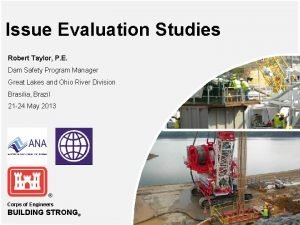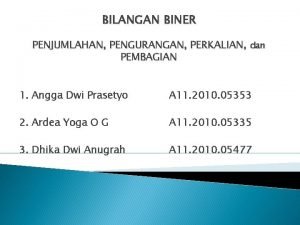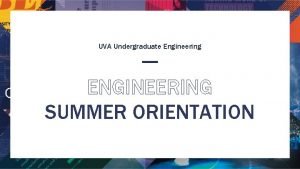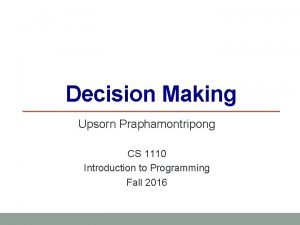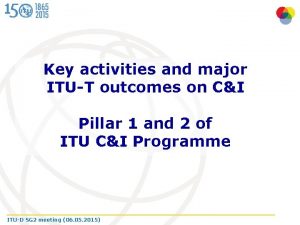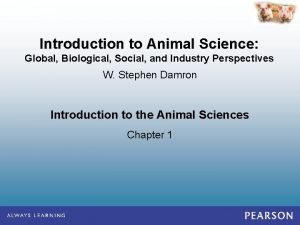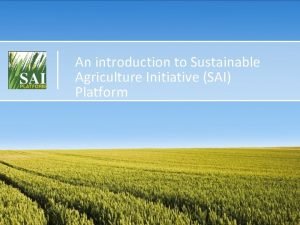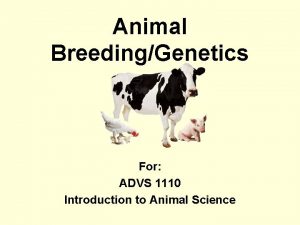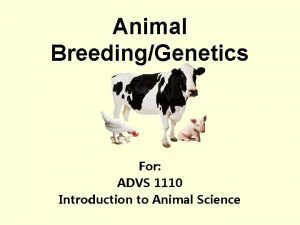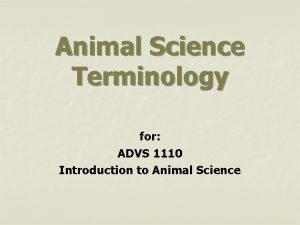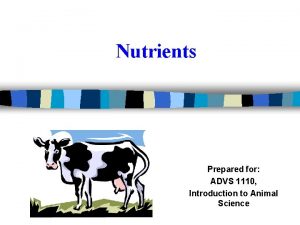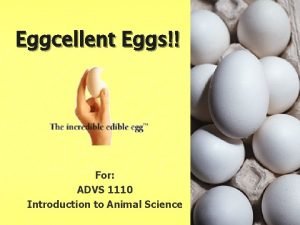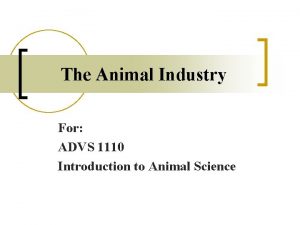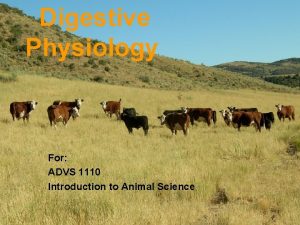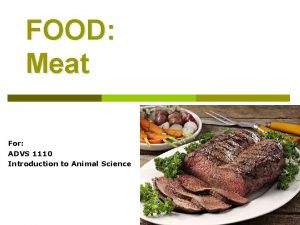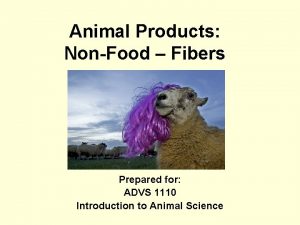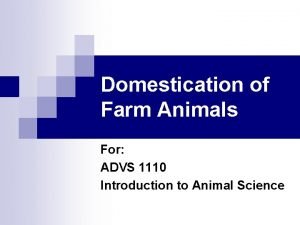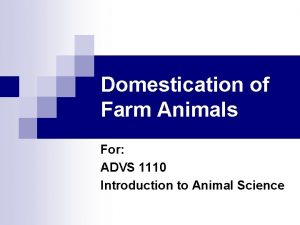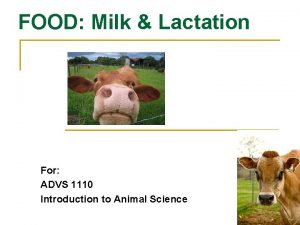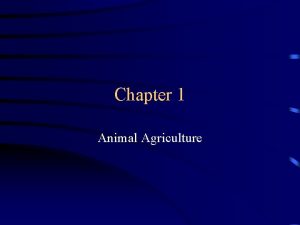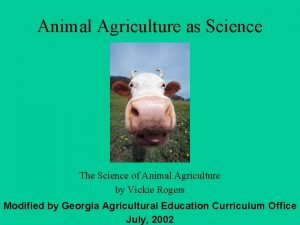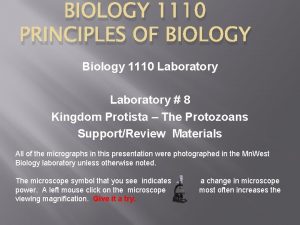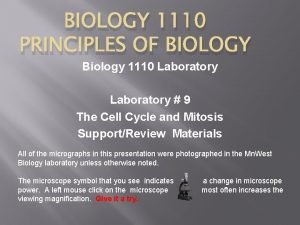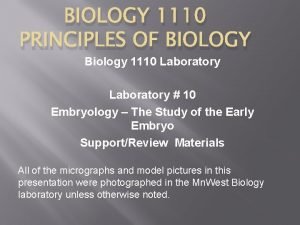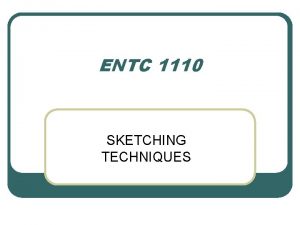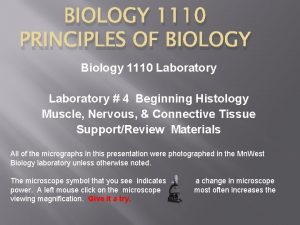Animal Science in Agriculture For ADVS 1110 Introduction














































































- Slides: 78

Animal Science in Agriculture For: ADVS 1110 Introduction to Animal Science

‘Every blade of grass is a study; and to produce two, where there was but one, is both a profit and a pleasure. ” - Abraham Lincoln, 30 September 1859, (address before the Wisconsin State Agricultural Society)

Prepared For:

The following people: 1. Those who procure food. 2. Those who like animals. 3. Those who want to learn about animal science. 4. Those who wish to graduate with a B. S. degree from USU. 5. Those who aren’t sure yet what trail to take. 6. Did I leave anyone out?

Science is: The study or theoretical explanation of natural phenomena. l During this time of study we are investigating the laws of nature, her principles and reasons. l

Agriculture l Oldest and most important of all sciences.

Without an Understanding of Agriculture, all humans would be struggling for survival!

Most of our comforts come as a direct result of science. l Food l Shelter l Clothing

Early people ate fruits, nuts and other seeds. They were migratory hunters. l The idea of domestication came about and people began to settle down. l

People began to pay close attention to details: l These details drew conclusions on where to locate and harvest food.

Progressive Scientific Education & Research : U. S. agriculture and animal husbandry studies began at Michigan Ag College in 1855. l Prior to this, universities were only teaching the “classics” such as Latin and Greek, History, Math and Philosophy. l

Soon they realized! l They should include more practical, hands-on subject areas in their curriculum.

1862 Senator Justin S. Morrill from Vermont l Morrill pushed for a bill through the U. S. Congress that would provide public land funds for colleges that would teach practical methods of food production.

1862 Senator Justin S. Morrill from Vermont Every State was to have their own A&M College/University. l Agriculture & Mechanical Arts (now known as Engineering) l

The bill was signed by President Lincoln: l The “Land Grant Act” or Morrill Act of 1862” was passed into law.

1862 l Another bill was passed into law which established the United States Department of Agriculture (USDA) during the same Congress.

1862 l A third important bill was also passed into law in 1862 that mostly affected the Western U. S.

1862 It was the “Homestead Act” which entitled ‘homesteaders’ to 160 acres l The people had to live on the land develop it for Agriculture. l

1862 l Thus, in 1862, during the bloodiest period of the American Civil War, President Lincoln signed three (3) important laws that continue to affect us today: 1. Morrill Act or Land Grant Act (Ag & Mechanical Arts Colleges, aka A&M’s) in every State 2. U. S. Department of Agriculture formed 3. Homestead Act for Western agriculture development

1887 l With the growing need and interest in agriculture, the government put the new ideas and concepts for agricultural practices to work.

1887 l The Hatch Act of 1887 set up the Agricultural Experiment Stations (AES) to be utilized by the Land Grant Universities in every State of the Union. l Fig. Spraying fruit trees at USAC AES in 1898.

Entry Gates To USAC 1940’s

1914 The “Smith-Lever Act” of 1914 established the Cooperative Extension Service. l This Act established outreach faculty from the Land Grant Colleges at the State and County level, i. e. County Extension Agents, 4 -H Agents, Home Agents, etc. l

1914 l The Smith-Lever Act finalized the third major arm of the Land Grant Colleges. l Fig. Dairy judging contest in 1940’s.

Thus, the Land Grant System: l Comprised of the following missions: l Teaching (resident) agricultural and mechanical arts; l Research, Agricultural Experiment Stations; l Extension, (Cooperative Extension Service) outreach service throughout the State at the County, Region, and State levels to those involved in agriculture and youth programs.

The Land Grant System l Universities conduct the research, methods tested at experiment stations, brought to public by extension. l Fig. USAC Animal Science building at 1923.

1917 l The “Smith-Hughes Act” established funding for Vocational Agricultural education programs in high schools.

Scientific Method

Scientific Method Systematic method of gaining knowledge through experimentation (research). l Assures that results did not occur justby-chance and that something actually caused the change. l

Scientific Method Process: l Recognize a Problem l Develop a Hypothesis l Do an experiment l Collect the Data l Analyze Data l Draw a Conclusion

and l Results are to make a recommendation or implication to those interested or impacted.

Identify the Problem to Be Solved: • Animal health, efficiency of production, nutrition, reproduction, management technique……

Form a Hypothesis An educated guess. l This is a guess of what might be causing the problem and/or what the solution is. l

Conduct the Experiment l Experiment should test the hypothesis.

Two Groups to Most Experiments 1. 2. Control Group - is constant and not treated. Experimental or Treatment Group contains everything that the control group does, but also contains the variable being tested.

Two Types of Research 1. Basic - looks at why or how processes occur.

Two Types of Research 2. Applied - uses the discoveries made in basic research to help in a practical manner.

Where The Research Has Led Us l Agriculture today, is the application of many years worth of knowledge gleaned from science based research.

Basic Research l Basic Research has taught us to produce high-quality, protein and energy rich food very efficiently.

Research Some research achievements: l Control of parasites and diseases l Protein-dense products

Animal Productivity & Efficiency Example: l l Of all species, broilers feed efficiency is most remarkable. Today, broilers are market ready in 7. 5 weeks after only 2. 0 lbs of feed/lb. of gain. It used to take 4. 0 lbs of feed/lb. of gain and 15 weeks

Research § The countries in North and Central America, Europe, Australia and New Zealand have only about 30%of the worlds cattle yet produce nearly 68% of the worlds beef and veal.

Research l These are the countries that have conducted the most agriculture research and embraced the resulting knowledge.

Research Milestones: l Animal Immunization: l Late 1800’s, disease devastated all types of animals l Louis Pasteur developed first method of vaccinating animals to develop immunity (1870 -80’s)

Research Milestones: l First vaccine developed to fight anthrax bacterium from the blood of sheep that had survived a bout with the disease. l Fig. Image of bacillus anthracis, gram positive anthrax bacteria.

Vaccine Tested in Two Groups: Group 1 - injected with the vaccine and later infected with anthrax. l Group 2 - infected with just anthrax. l

Results: Group 1 - sheep lived l Group 2 - sheep died l

Vaccines for Other Diseases l Using Pasteur’s guidelines other scientists developed vaccines for other diseases.

Animals Raised in: l Research also proved that animals reared in a clean, comfortable environment produce more efficiently and more economically.

Refrigeration l There is a great need for meat preservation. l Meat spoils quickly. l Historically, meat was harvested in the fall to take advantage of natures cool temperatures.

Historical Meat Preservative Methods l Salt l Drying l Keeping meat in a cool stream. l Packing meat in ice and wood shavings.

Historical Preservation Problems: l Inefficient l Unsafe l Unpalatable l Fig. An early ‘ice box’.

Results: Today l We have freezers and refrigerators which utilize chemicals and compressors to condition the air and keep it cool and clean. l Fig. An early refrigerator with compressor on top.

Refrigeration: l First attempt of meat cooling was done with huge blocks of ice being hung from the ceilings of dark rooms. l Fig. UPRR crews harvesting ice blocks from lake in 1940’s.

Refrigeration: l Refrigerated box cars were developed a few years later.

Refrigeration: l By 1950 over 80% of American households had a modern refrigerator, similar to the one shown here.

Artificial Insemination: l Advancements in animal production is achieved through using superior individuals to transfer genes from parent to offspring, also referred to as ‘artificial selection’.

Artificial Insemination: l Artificial Insemination (A. I. ) developed in the 1930’s, allows us to exploit the genes from superior sires. Two ejaculates in one collection day from a bull can yield over 500 doses of viable semen.

Artificial Insemination: l A. I. is widely available today for all species of farm animals, but utilized the most in the poultry and dairy industries.

Embryo Transfer: l Allows for genes of superior females to be propagated.

Combining ET and AI l Allows producers to make rapid gains in the genetic quality of their herds in short amounts of time at relatively low cost.

Computers: l Computer developed in the 1940’s became an an integral part of agriculture in the 1980’s. l Research moves more swiftly as computers allow us to analyze data in seconds instead of weeks or longer.

Computers: l Computers allow us to do simulated experiments plus numerous other analysis. l Animal Science applied uses: l Progeny records l Production records

Computers: l Precision Agriculture: l Nutrition l Production records l Health records l Inventory l Financial records l Reproduction l Much more

Animals Impact on Our Everyday Life: Lives of humans have been greatly enhanced through pharmaceuticals developed from animal by-products. l Many routinely prescribed drugs are derived from animals. l

Pharmaceuticals: l Cortisone was originally made from the gall bladder of cows.

Pharmaceuticals: l Insulin came from the pancreas of pigs. l Many hormones used in treating humans are derived from animal origin. l Many of these products are now produced Synthetically.

Other Benefits to Humankind: l l Animal parts can be used as replacements for humans organs and tissues. Heart valves from pigs have been used in humans for many years.

Other Benefits to Humankind: l Pig skin is used in treating burn patients. It is laid over the burnt area until new skin grows naturally.

U. S. Agriculture is Awesome! l The rest of the world hopes to compete with the efficiency, health, safety, and overall quality of the products produced from U. S. agriculture.

U. S. Agriculture is Awesome! l Our research, combined with the free enterprise system, has made US #1 in the world in agricultural production.

Land-Ruminant-Human Relationships Land Primary Plant Product Grains, Oilseeds, Roots, Tubers, Fruits, Nuts, Vegetables, Sugar Crops Crop Residue Permanent Pastures, Grasslands, Rangeland Harvested Forage

Land-Ruminant-Human Relationships Grains, Oilseeds, Roots, Tubers, Fruits, Nuts, Vegetables, Sugar Crops Agri-Industrial By-Products Crop Residue Permanent Pastures, Grasslands, Rangeland Non-protein Nitrogen (NPN) Feed for Ruminants Harvested Forage Animal Wastes

Land-Ruminant-Human Relationships Feed for Ruminants Manure Fuel Meat, Milk Processing Wastes Food Wool, Hair Hides, etc. Draft Transport

Now, aren’t you glad to be attending Utah State University, Utah’s only designated Land Grant University?

The End…. No, only your beginning! Welcome aboard.

“Prepare to fail, if you fail to prepare. ” - Anonymous

Don’t forget…. . You’re now an “Aggie”
 Advs
Advs Er 1110-2-1156
Er 1110-2-1156 Pengurangan biner
Pengurangan biner Uva math placement
Uva math placement Bilangan biner bertanda 8 bit
Bilangan biner bertanda 8 bit Số 1101001 ở hệ nhị phân
Số 1101001 ở hệ nhị phân Upsorn praphamontripong
Upsorn praphamontripong Itu-t p.1100
Itu-t p.1100 Importance of animal science
Importance of animal science What is my favourite subject
What is my favourite subject Science fusion online
Science fusion online Introduction of sustainable agriculture
Introduction of sustainable agriculture Introduction of agriculture
Introduction of agriculture Introduction to smart agriculture
Introduction to smart agriculture Sai platform members
Sai platform members Kontinuitetshantering
Kontinuitetshantering Novell typiska drag
Novell typiska drag Tack för att ni lyssnade bild
Tack för att ni lyssnade bild Vad står k.r.å.k.a.n för
Vad står k.r.å.k.a.n för Varför kallas perioden 1918-1939 för mellankrigstiden?
Varför kallas perioden 1918-1939 för mellankrigstiden? En lathund för arbete med kontinuitetshantering
En lathund för arbete med kontinuitetshantering Adressändring ideell förening
Adressändring ideell förening Tidbok
Tidbok Sura för anatom
Sura för anatom Förklara densitet för barn
Förklara densitet för barn Datorkunskap för nybörjare
Datorkunskap för nybörjare Tack för att ni lyssnade bild
Tack för att ni lyssnade bild Debattartikel mall
Debattartikel mall Magnetsjukhus
Magnetsjukhus Nyckelkompetenser för livslångt lärande
Nyckelkompetenser för livslångt lärande Påbyggnader för flakfordon
Påbyggnader för flakfordon Lufttryck formel
Lufttryck formel Svenskt ramverk för digital samverkan
Svenskt ramverk för digital samverkan Lyckans minut erik lindorm analys
Lyckans minut erik lindorm analys Presentera för publik crossboss
Presentera för publik crossboss Argument för teckenspråk som minoritetsspråk
Argument för teckenspråk som minoritetsspråk Bat mitza
Bat mitza Treserva lathund
Treserva lathund Epiteltyper
Epiteltyper Claes martinsson
Claes martinsson Cks
Cks Lågenergihus nyproduktion
Lågenergihus nyproduktion Mat för unga idrottare
Mat för unga idrottare Verktyg för automatisering av utbetalningar
Verktyg för automatisering av utbetalningar Rutin för avvikelsehantering
Rutin för avvikelsehantering Smärtskolan kunskap för livet
Smärtskolan kunskap för livet Ministerstyre för och nackdelar
Ministerstyre för och nackdelar Tack för att ni har lyssnat
Tack för att ni har lyssnat Mall för referat
Mall för referat Redogör för vad psykologi är
Redogör för vad psykologi är Stål för stötfångarsystem
Stål för stötfångarsystem Tack för att ni har lyssnat
Tack för att ni har lyssnat Borra hål för knoppar
Borra hål för knoppar Vilken grundregel finns det för tronföljden i sverige?
Vilken grundregel finns det för tronföljden i sverige? Variansen formel
Variansen formel Tack för att ni har lyssnat
Tack för att ni har lyssnat Rita perspektiv
Rita perspektiv Ledningssystem för verksamhetsinformation
Ledningssystem för verksamhetsinformation Tobinskatten för och nackdelar
Tobinskatten för och nackdelar Blomman för dagen drog
Blomman för dagen drog Modell för handledningsprocess
Modell för handledningsprocess Egg för emanuel
Egg för emanuel Elektronik för barn
Elektronik för barn Plagg i gamla rom
Plagg i gamla rom Strategi för svensk viltförvaltning
Strategi för svensk viltförvaltning Kung dog 1611
Kung dog 1611 Indikation för kejsarsnitt på moderns önskan
Indikation för kejsarsnitt på moderns önskan Sju för caesar
Sju för caesar Tack för att ni lyssnade
Tack för att ni lyssnade Större än
Större än Upprepning dikt
Upprepning dikt Inköpsprocessen steg för steg
Inköpsprocessen steg för steg Rbk fuktmätning
Rbk fuktmätning Etik och ledarskap etisk kod för chefer
Etik och ledarskap etisk kod för chefer Vad är hsil
Vad är hsil Myndigheten för delaktighet
Myndigheten för delaktighet Trög för kemist
Trög för kemist Sju principer för tillitsbaserad styrning
Sju principer för tillitsbaserad styrning Läkarutlåtande för livränta
Läkarutlåtande för livränta

